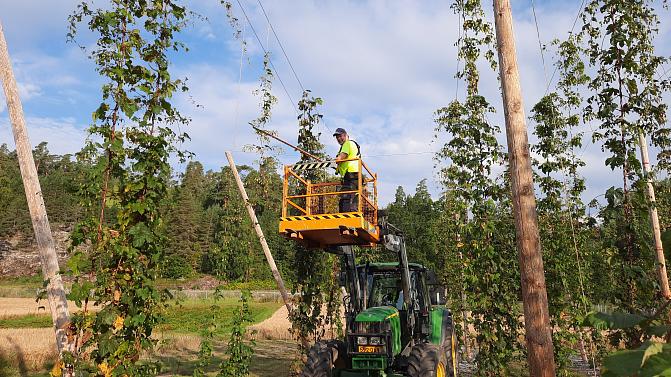
Hops research meets demand from farmers and brewers
On this page
For more than a decade, brewers and farmers have been hoping to bring Finnish hops to the market, both as a source of additional income alongside other crops and to bring new flavours to brewing products. So far, hops are grown on less than ten hectares in Finland. Cultivation has been limited by the lack of varieties that can be grown in northern light conditions and by a lack of knowledge and experience of the basics of hop growing. Currently, hop pellets and extracts are imported from abroad, mainly from other parts of Europe and the United States. Hops have been grown in Finland for centuries, and the harvest has been used to make mead, farmhouse ale and beer.


Research to select the most suitable Finnish hops for production
The Natural Resources Institute Finland has been mapping crop hops grown in Finland for a long time. Twenty of the more than 1,000 hops reported by the public were selected for experimental cultivation on the basis of genetic and chemical analysis. The experimental plantations have been established at Luke's Piikkiö site and on school premises in South Ostrobothnia and Lapland.
A few of the hops grown in the experiments will be selected and designated as the most suitable strain for production and added to the nurseries. The field trials will collect information on the external characteristics, yield potential and resistance to plant diseases of the plant strains. The dried hop cone crop is chemically analysed for aroma compounds and bittering alpha and beta acids. Sensory analysis provides valuable information on the potential of hops in the final product. This is done by evaluating the aromatic odours of the cones and testing the suitability of the hops as a brewing product in a brewing trial.
Crop technology research to help farmers with initial inputs
Hop growing differs in many ways from cereal growing. The perennial, up to ten-metre-high eminence requires solidly built support structures and special machinery for harvesting and handling the crop. It is important that the aromatic oils contained in the hop cone are preserved during harvesting and processing.
To promote the cultivation, Luke has published a guide on how to set up a hop farm and its basic cultivation techniques in 2023, and an online tool for calculating the profitability of hop cultivation, which can be used to estimate when and how much profit can be made.
Currently, one of the objectives of hop research in Finland is to identify ways of integrated pest management for hops. For example, maintaining flower strips between hop rows can favour natural enemies of pests such as flower flies, spiders and ladybirds.


A service to help hop farmers to get off to a fast start
The expertise accumulated through research on Finnish hops, including a library of hop genetics and chemical composition and the production of pure plant material from cell culture, has enabled the establishment of the Hops Services concept (in Finnish) at Luke. Farmers can study the genetic uniqueness of their hops, the aroma and acidity of the cones and produce pure planting material from their material for their fields. The service has been available for two years and has been put to good use.
Farmers can study the genetic uniqueness of their hops, the aroma and acidity of the cones and produce pure planting material from their material for their fields.
The Natural Resources Institute Finland has two ongoing hop projects, the Arctic Hop for Breweries (2022–2025; Makera) and the Quality Hop (Laatuhumala 2022–2024; OLVI-säätiö, (in Finnish)). There are also plans to exploit the entire biomass of the vine, for example in fibre research. The brewing laboratory Powered by Luke will contribute to the development of the hop production chain in Finland.


